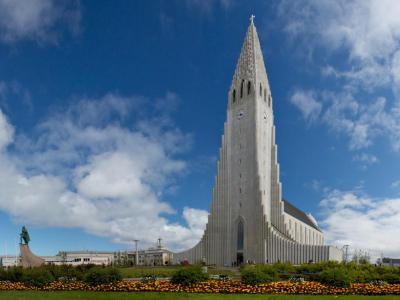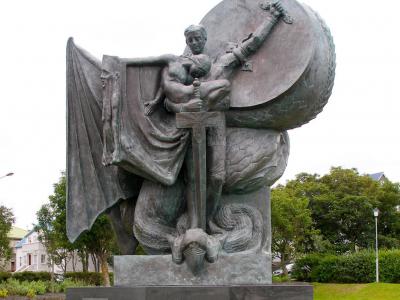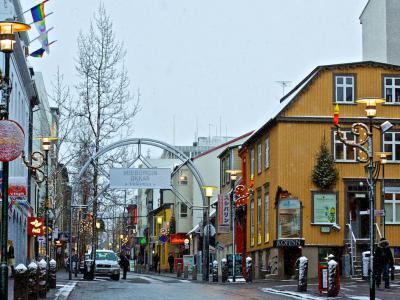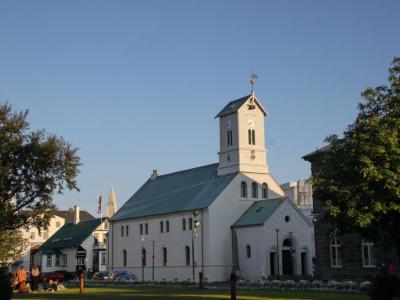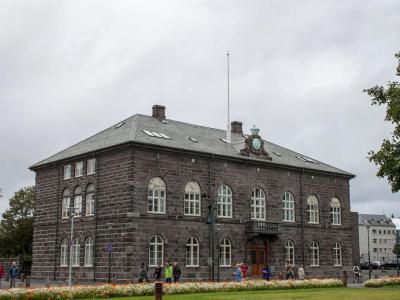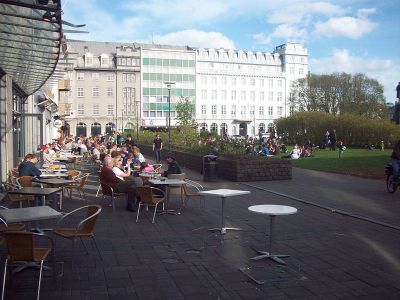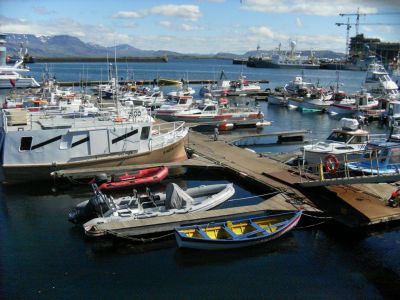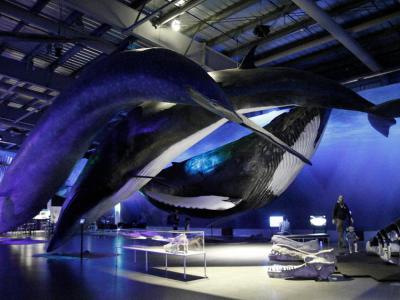
Reykjavik Introduction Walking Tour (Self Guided), Reykjavik
Reykjavik is the capital city of Iceland. Located close to the Arctic Circle, it is the world's northernmost capital. This charming, eclectic destination is the center of Iceland's economy, culture, and government.
Reykjavík is considered to be Iceland's first settlement. According to ancient texts, Norseman Ingolfr Arnarson was drawn to Reykjavík's natural harbor and nearby hot springs and settled here in AD 874. Reykjavík can be loosely translated as Smoky Cove, referring to the steam rising from hot springs.
Iceland was governed by the Althing, or national parliament, as an independent commonwealth until the 13th century, when it acceded to Norwegian and then Danish rule. The national parliament has met since 930 AD and is considered the world's oldest parliamentary system. Reykjavik was officially founded in 1785. Iceland gained firstly partial and then complete independence from Denmark in 1918 and 1944, respectively.
Visitor and ascend the tower at Iceland's tallest church, the Church of Hallgrímur. Here, you'll be rewarded with astounding views of Reykjavík and the surrounding landscape. This iconic church was designed to emulate Iceland's dramatic landscape.
Austurvollur Square acts as Reykjavík's main square and is home to several significant buildings. The Reykjavik Cathedral is another inspiring church with historical and cultural significance. Parliamentarians meet here for mass before walking to The Parliament House, and Presidents are inaugurated at this remarkable church.
Next door, the Parliament House houses a parliamentary debating chamber for the oldest parliamentary institution in the world. Visitors can admire the captivating works of Iceland's first sculptor, Einar Jónsson, in the Einar Jónsson Museum and Sculpture Garden.
Don't miss a stroll down Laugavegur Street. Here, you can visit two museums and shop for high-end Icelandic designs and fun souvenirs. The Harpa Concert Hall and Conference Centre offers a full range of concerts and shows and will dazzle you with its modern design.
Reykjavik Old Harbor is the perfect place to soak up Reykjavik's culture, enjoy Icelandic cuisine, head out on a wildlife watching tour, or visit a world-class museum.
Take this self-guided walking tour to soak up the sights of this exceptional city.
Reykjavík is considered to be Iceland's first settlement. According to ancient texts, Norseman Ingolfr Arnarson was drawn to Reykjavík's natural harbor and nearby hot springs and settled here in AD 874. Reykjavík can be loosely translated as Smoky Cove, referring to the steam rising from hot springs.
Iceland was governed by the Althing, or national parliament, as an independent commonwealth until the 13th century, when it acceded to Norwegian and then Danish rule. The national parliament has met since 930 AD and is considered the world's oldest parliamentary system. Reykjavik was officially founded in 1785. Iceland gained firstly partial and then complete independence from Denmark in 1918 and 1944, respectively.
Visitor and ascend the tower at Iceland's tallest church, the Church of Hallgrímur. Here, you'll be rewarded with astounding views of Reykjavík and the surrounding landscape. This iconic church was designed to emulate Iceland's dramatic landscape.
Austurvollur Square acts as Reykjavík's main square and is home to several significant buildings. The Reykjavik Cathedral is another inspiring church with historical and cultural significance. Parliamentarians meet here for mass before walking to The Parliament House, and Presidents are inaugurated at this remarkable church.
Next door, the Parliament House houses a parliamentary debating chamber for the oldest parliamentary institution in the world. Visitors can admire the captivating works of Iceland's first sculptor, Einar Jónsson, in the Einar Jónsson Museum and Sculpture Garden.
Don't miss a stroll down Laugavegur Street. Here, you can visit two museums and shop for high-end Icelandic designs and fun souvenirs. The Harpa Concert Hall and Conference Centre offers a full range of concerts and shows and will dazzle you with its modern design.
Reykjavik Old Harbor is the perfect place to soak up Reykjavik's culture, enjoy Icelandic cuisine, head out on a wildlife watching tour, or visit a world-class museum.
Take this self-guided walking tour to soak up the sights of this exceptional city.
How it works: Download the app "GPSmyCity: Walks in 1K+ Cities" from Apple App Store or Google Play Store to your mobile phone or tablet. The app turns your mobile device into a personal tour guide and its built-in GPS navigation functions guide you from one tour stop to next. The app works offline, so no data plan is needed when traveling abroad.
Reykjavik Introduction Walking Tour Map
Guide Name: Reykjavik Introduction Walking Tour
Guide Location: Iceland » Reykjavik (See other walking tours in Reykjavik)
Guide Type: Self-guided Walking Tour (Sightseeing)
# of Attractions: 11
Tour Duration: 2 Hour(s)
Travel Distance: 3.8 Km or 2.4 Miles
Author: vickyc
Sight(s) Featured in This Guide:
Guide Location: Iceland » Reykjavik (See other walking tours in Reykjavik)
Guide Type: Self-guided Walking Tour (Sightseeing)
# of Attractions: 11
Tour Duration: 2 Hour(s)
Travel Distance: 3.8 Km or 2.4 Miles
Author: vickyc
Sight(s) Featured in This Guide:
- Hallgrímskirkja (Church of Hallgrímur)
- Einar Jónsson Museum and Sculpture Garden
- Laugavegur Street
- Prikid
- Dómkirkjan (Reykjavík Cathedral)
- Althingishus (The Parliament House)
- Austurvöllur Square
- Harpa Concert Hall and Conference Centre
- Reykjavik Old Harbor
- Aurora Reykjavik
- Whales of Iceland Exhibition
1) Hallgrímskirkja (Church of Hallgrímur) (must see)
Standing at 74 meters (244 feet) tall, the striking Church of Hallgrímur is Iceland's tallest church. Architect Guojon Samuelsson began drawing the church in 1937. Construction began in 1945 and was completed in 1986.
Iceland's unique geography inspired the design of the church. Volcanic action created lava flows which cooled into grey, hexagonal columns. The dramatic, cool, jagged columns inspired the design of the Church of Hallgrímur.
The church was named after 17th-century clergyman and poet Hallgrimur Petursson. Hallgrimur Petursson was best known for his work Hymns of the Passion.
This iconic building is visible from many parts of Reykjavík. The Church of Hallgrímur is a Lutheran, or Church of Iceland establishment. Its impressive height was in part to compete with Landakot's Church, the Catholic Cathedral.
During the summer, visitors can enjoy concerts which run four days a week. Don't miss the incredible pipe organ that stands 15 meters (49 feet) tall. The pipe organ has electronic action; the pipes are remote from the pedal console. The organ has 5,275 pipes and has been featured in several recording albums.
Outside the entrance, visitors will find a statue of Leif Eriksson, a famed explorer. The United States gave the statue to Iceland in the 1930s to commemorate the 1,000th anniversary of the Icelandic Parliament. The Icelandic Parliament was first convened in the year 930 AD.
The large clock on the tower is often wrong, as strong Icelandic wind gusts often blow the hands about.
Why You Should Visit:
The Church of Hallgrímur is a dramatic church that wonderfully emulates Iceland's landscape. You will see the church's tower from all over the city and find the church even more impressive up close. The interior is surprisingly austere with clean lines.
Tips:
Admission is free, but a small fee provides access to a lift to the top of the building, where visitors can enjoy panoramic views of Reykjavik and the surrounding mountains.
Iceland's unique geography inspired the design of the church. Volcanic action created lava flows which cooled into grey, hexagonal columns. The dramatic, cool, jagged columns inspired the design of the Church of Hallgrímur.
The church was named after 17th-century clergyman and poet Hallgrimur Petursson. Hallgrimur Petursson was best known for his work Hymns of the Passion.
This iconic building is visible from many parts of Reykjavík. The Church of Hallgrímur is a Lutheran, or Church of Iceland establishment. Its impressive height was in part to compete with Landakot's Church, the Catholic Cathedral.
During the summer, visitors can enjoy concerts which run four days a week. Don't miss the incredible pipe organ that stands 15 meters (49 feet) tall. The pipe organ has electronic action; the pipes are remote from the pedal console. The organ has 5,275 pipes and has been featured in several recording albums.
Outside the entrance, visitors will find a statue of Leif Eriksson, a famed explorer. The United States gave the statue to Iceland in the 1930s to commemorate the 1,000th anniversary of the Icelandic Parliament. The Icelandic Parliament was first convened in the year 930 AD.
The large clock on the tower is often wrong, as strong Icelandic wind gusts often blow the hands about.
Why You Should Visit:
The Church of Hallgrímur is a dramatic church that wonderfully emulates Iceland's landscape. You will see the church's tower from all over the city and find the church even more impressive up close. The interior is surprisingly austere with clean lines.
Tips:
Admission is free, but a small fee provides access to a lift to the top of the building, where visitors can enjoy panoramic views of Reykjavik and the surrounding mountains.
2) Einar Jónsson Museum and Sculpture Garden
Einar Jónsson is regarded as Iceland's first sculptor. Einar was born on a farm in southern Iceland in 1874. He had an artistic soul and traveled to Denmark to study art, and then continued his studies in Rome before returning to Denmark. Finally, in 1909, he agreed to return to Iceland. The Althing (Icelandic parliament) would provide Einar a museum and home, and in return, Einar would donate his sculptures to the museum.
Einar's works are primarily completed in plaster. Iceland doesn't have traditional modeling clay, and plaster allowed Einar to continue to work on his sculptures over extended time periods.
Einar produced public commissions, such as his 1920 Thorfinn Karlsefni. He also produced private commissions, such as his 1936 Monument to Dr. Charcot and His Ship. Finally, he produced artworks for the sake of creating art, such as Trees of Life and Death, which he worked on from 1909 to 1940.
The Einar Jónsson Museum was completed in 1923 and is Iceland's first art museum. Visitors can admire 300 of Einar's sculptures in the museum. Einar rejected classical sculpture and traditional art, preferring to follow his own path. His art encompasses Nordic folklore, Christian ideas, and figurative works.
Einar's apartment is also open to the public. Einar lived in the apartment above the museum until he died in 1954. Here, visitors can gain insight into Einar's fascinating life.
The sculpture garden contains 26 of Einar's bronze sets, including The Wave of Ages, The King of Atlantis, and Thor Wrestling with Age.
Einar's works are primarily completed in plaster. Iceland doesn't have traditional modeling clay, and plaster allowed Einar to continue to work on his sculptures over extended time periods.
Einar produced public commissions, such as his 1920 Thorfinn Karlsefni. He also produced private commissions, such as his 1936 Monument to Dr. Charcot and His Ship. Finally, he produced artworks for the sake of creating art, such as Trees of Life and Death, which he worked on from 1909 to 1940.
The Einar Jónsson Museum was completed in 1923 and is Iceland's first art museum. Visitors can admire 300 of Einar's sculptures in the museum. Einar rejected classical sculpture and traditional art, preferring to follow his own path. His art encompasses Nordic folklore, Christian ideas, and figurative works.
Einar's apartment is also open to the public. Einar lived in the apartment above the museum until he died in 1954. Here, visitors can gain insight into Einar's fascinating life.
The sculpture garden contains 26 of Einar's bronze sets, including The Wave of Ages, The King of Atlantis, and Thor Wrestling with Age.
3) Laugavegur Street (must see)
Laugavegur Street is Reykjavik's main shopping street. Visitors will find restaurants, bars, cafes, and boutique shops.
Laugavegur is one of the oldest streets in Reykjavík. The name can be translated as the Water Road. Here, women would bring their laundry to be washed in hot pools.
Laugavegur is just over a mile or two kilometers long. The shopping stretch starts at the city's busy bus center, Hlemmur, and continues to Bankastraeti.
There are two museums on Laugavegur. First, the Phallological Museum is the world's only museum dedicated to the male genitals, with specimens from the animal kingdom. The second museum is a small punk museum.
Most of the shops feature Icelandic designs and brands. Visitors will find high-end products, as well as shops with souvenirs such as books, fridge magnets, and stuffed animals.
Visitors can also find a variety of vintage shops and second-hand goods along Laugavegur.
Foodies will be delighted with the variety of options. Try traditional Icelandic menus or international cuisines. Visitors can also find vegan restaurants.
Several bars feature live music. Movie fans will love the Lebowski Bar, with food and "wheel of fortune" rounds.
Laugavegur is a diverse street with something for everyone.
Laugavegur is one of the oldest streets in Reykjavík. The name can be translated as the Water Road. Here, women would bring their laundry to be washed in hot pools.
Laugavegur is just over a mile or two kilometers long. The shopping stretch starts at the city's busy bus center, Hlemmur, and continues to Bankastraeti.
There are two museums on Laugavegur. First, the Phallological Museum is the world's only museum dedicated to the male genitals, with specimens from the animal kingdom. The second museum is a small punk museum.
Most of the shops feature Icelandic designs and brands. Visitors will find high-end products, as well as shops with souvenirs such as books, fridge magnets, and stuffed animals.
Visitors can also find a variety of vintage shops and second-hand goods along Laugavegur.
Foodies will be delighted with the variety of options. Try traditional Icelandic menus or international cuisines. Visitors can also find vegan restaurants.
Several bars feature live music. Movie fans will love the Lebowski Bar, with food and "wheel of fortune" rounds.
Laugavegur is a diverse street with something for everyone.
4) Prikid
Prikid opened in 1951 and is one of Iceland's longest-running coffee houses and restaurants. The classic interior gives the restaurant a timeless feel. The brightly-colored exterior is warm and inviting.
In the morning, stop by for a coffee or a filling breakfast. In the afternoon, you might find local families grabbing a bite to eat. Prikid is a go-to place for satisfying bar food.
In the evenings and on weekends, the bar is lively and offers cheap beers, a nice relief in an expensive city. Prikid also offers two-for-one beers during happy hour.
The menu includes burgers and coffee but also has several vegan options. The five-dollar milkshake is a fan favorite, but inflation has made this item much more expensive than five dollars!
On the weekends, you'll find Prikid is the place to be. Live music performances, stand-up comedians, and DJs provide entertainment.
In the morning, stop by for a coffee or a filling breakfast. In the afternoon, you might find local families grabbing a bite to eat. Prikid is a go-to place for satisfying bar food.
In the evenings and on weekends, the bar is lively and offers cheap beers, a nice relief in an expensive city. Prikid also offers two-for-one beers during happy hour.
The menu includes burgers and coffee but also has several vegan options. The five-dollar milkshake is a fan favorite, but inflation has made this item much more expensive than five dollars!
On the weekends, you'll find Prikid is the place to be. Live music performances, stand-up comedians, and DJs provide entertainment.
5) Dómkirkjan (Reykjavík Cathedral)
Reykjavik Cathedral is a neoclassical church designed by Andreas Kirkerup in the 18th century. The Cathedral is centrally located in Austurvollur, Reykjavik's main public square. Reykjavik Cathedral is the seat of the Bishop of Iceland and the Evangelical Lutheran Church of Iceland. It also serves as the parish church for the city center.
This site has been dedicated to churches since the 13th century. Work on the current church began in 1788, and the Reykjavik Cathedral was dedicated in 1796. It was the first building to be completed with the notion that Reykjavik would become the capital of Iceland.
Since 1845, each parliament session begins with mass at the Cathedral, and then members of parliament go together to the parliament house.
The church and Parliament are intertwined and are a central facet of life in Iceland.
The organ was built in Berlin in 1985 and has 31 voices and three manuals. Sculptor Albert Thorvaldsen designed the baptismal font. Leifur Breiofjoro, an Icelandic artist, designed the processional cross.
Reykjavik Cathedral is smaller and less imposing than the Church of Hallgrimur. However, it boasts a rich cultural history and has significant meaning in the daily lives of Iceland's Lutherans. The Christmas mass is broadcasted from Reykjavik Cathedral, and people all over the country tune in to listen to it. New Presidents are inaugurated at Reykjavík Cathedral.
This site has been dedicated to churches since the 13th century. Work on the current church began in 1788, and the Reykjavik Cathedral was dedicated in 1796. It was the first building to be completed with the notion that Reykjavik would become the capital of Iceland.
Since 1845, each parliament session begins with mass at the Cathedral, and then members of parliament go together to the parliament house.
The church and Parliament are intertwined and are a central facet of life in Iceland.
The organ was built in Berlin in 1985 and has 31 voices and three manuals. Sculptor Albert Thorvaldsen designed the baptismal font. Leifur Breiofjoro, an Icelandic artist, designed the processional cross.
Reykjavik Cathedral is smaller and less imposing than the Church of Hallgrimur. However, it boasts a rich cultural history and has significant meaning in the daily lives of Iceland's Lutherans. The Christmas mass is broadcasted from Reykjavik Cathedral, and people all over the country tune in to listen to it. New Presidents are inaugurated at Reykjavík Cathedral.
6) Althingishus (The Parliament House)
Danish architect Ferdinand Meldahl designed The Parliament House Completed in 1881, The Parliament House is a classical building and was built using hewn dolerite, a subvolcanic rock. It is known as one of the oldest stone buildings in Iceland.
Reliefs on the tympanums represent Iceland's four Land Spirits. The dragon, a vulture, a bull, and a giant represent these traditional Norse spirits. On the north side of the building, visitors will notice King Christian IX's crown and crest.
The Parliament House is home to Althingi, the Icelandic parliament. In the past, it was also used to house the University of Iceland and the offices of the President of Iceland.
Althingi was first held in Iceland in 930, and as such, is one of the oldest parliamentary institutions in the world. Meetings have been held at the Parliament House since 1884. Today, Parliament uses the debating chamber, meeting rooms, and staff offices. Parliamentarian's offices and larger meeting rooms are located in other buildings.
The charming garden behind The Parliament House is the oldest public garden in Iceland.
Reliefs on the tympanums represent Iceland's four Land Spirits. The dragon, a vulture, a bull, and a giant represent these traditional Norse spirits. On the north side of the building, visitors will notice King Christian IX's crown and crest.
The Parliament House is home to Althingi, the Icelandic parliament. In the past, it was also used to house the University of Iceland and the offices of the President of Iceland.
Althingi was first held in Iceland in 930, and as such, is one of the oldest parliamentary institutions in the world. Meetings have been held at the Parliament House since 1884. Today, Parliament uses the debating chamber, meeting rooms, and staff offices. Parliamentarian's offices and larger meeting rooms are located in other buildings.
The charming garden behind The Parliament House is the oldest public garden in Iceland.
7) Austurvöllur Square
Austurvollur Square is the main public square in Reykjavik and is home to several important landmarks. Here you will find The Parliament House, Reykjavik Cathedral, the Hotel Borg, as well as several popular restaurants, cafes, and bars.
Hotel Borg was built by Jóhannes Jósefsson, who competed in the 1908 Olympics. He traveled in America and returned to Iceland in 1927 with a dream of building a luxury hotel. Iceland was preparing to host celebrations for its 1,000th parliamentary anniversary. The hotel opened in 1930 and has hosted many politicians, dignitaries, and celebrities. Built in Art Deco style, the hotel is elegant and attractive.
A statue of Jon Sigurosson stands in the middle of the square. Jon Sigurosson was a leader of Iceland's independence movement in the 19th century.
In the summer, the square is filled with locals and tourists who enjoy the outdoor cafes. In the winter, the square is home to a large Christmas tree.
Hotel Borg was built by Jóhannes Jósefsson, who competed in the 1908 Olympics. He traveled in America and returned to Iceland in 1927 with a dream of building a luxury hotel. Iceland was preparing to host celebrations for its 1,000th parliamentary anniversary. The hotel opened in 1930 and has hosted many politicians, dignitaries, and celebrities. Built in Art Deco style, the hotel is elegant and attractive.
A statue of Jon Sigurosson stands in the middle of the square. Jon Sigurosson was a leader of Iceland's independence movement in the 19th century.
In the summer, the square is filled with locals and tourists who enjoy the outdoor cafes. In the winter, the square is home to a large Christmas tree.
8) Harpa Concert Hall and Conference Centre (must see)
Harpa Concert Hall and Conference Centre is a modern complex completed in 2011. It is the first purpose-built concert hall in Reykjavik. Harpa is home to the Iceland Symphony Orchestra and the Icelandic Opera's offices.
The modern building features different colored geometric-shaped glass panels over a steel framework.
The 1970 The Musician sculpture is located in the water next to Harpa. Icelandic sculptor Olof Palsdottir created the sculpture which shows a cellist playing. The statue used to be located at the previous home of the Iceland Symphony Orchestra, but it moved with the Orchestra to its new home.
The concert hall also hosts performances by the Icelandic Opera and the Reykjavik Big Band.
The building won the European Union's Mies van der Rohe Award for contemporary architecture in 2013. In addition, Harpa won the MICE Report Award for the best conference center in Northern Europe.
Harpa has appeared in the series Black Mirror and in an episode of the Netflix series Sense8. It hosts several regular shows such as How to Become Icelandic in 60 Minutes, Pearls of Icelandic Songs, Reykjavik Classics,and Bowie: The Session.
Harpa features modern architecture and is stunning at night.
The modern building features different colored geometric-shaped glass panels over a steel framework.
The 1970 The Musician sculpture is located in the water next to Harpa. Icelandic sculptor Olof Palsdottir created the sculpture which shows a cellist playing. The statue used to be located at the previous home of the Iceland Symphony Orchestra, but it moved with the Orchestra to its new home.
The concert hall also hosts performances by the Icelandic Opera and the Reykjavik Big Band.
The building won the European Union's Mies van der Rohe Award for contemporary architecture in 2013. In addition, Harpa won the MICE Report Award for the best conference center in Northern Europe.
Harpa has appeared in the series Black Mirror and in an episode of the Netflix series Sense8. It hosts several regular shows such as How to Become Icelandic in 60 Minutes, Pearls of Icelandic Songs, Reykjavik Classics,and Bowie: The Session.
Harpa features modern architecture and is stunning at night.
9) Reykjavik Old Harbor
The Old Harbor was built between 1913 and 1917 and was originally used for fisheries and trade. Reykjavik was made the capital city in part due to the economic importance of the Old Harbor. This natural harbor was the main draw to original Viking explorer Ingolfur Arnarson, who settled in this area. The harbor is still a vital contributor to the economy; however, today's economy is more driven by tourism.
Today, many tours leave from the harbor. Visitors can go on whale-watching tours and often see dolphins, Minke Whales, and Humpback Whales. Some lucky visitors will also see Blue, Fin, and Beaked Whales as well as Orcas.
Puffin-watching tours also leave from the harbor. Visitors who want to see the majestic Northern Lights blanketing a winter sky can brave the cold and go on a once-in-a-lifetime Northern Lights cruise.
Landside, the Old Harbor has been transformed from a working harborside to a trendy hotspot. Many of the colorful old fishing houses have been renovated into fabulous cafes, bars, and restaurants.
Baejarins Beztu hot dog stand opened in 1937 to serve fast food to fishermen. It's one of Iceland's oldest family-run businesses and has a unique claim to fame. Former U.S. President Bill Clinton had a hot dog here in 2004 and called it "the world's best hot dog." Matur & Drykkur is a fine-dining restaurant that serves traditional Icelandic fare and is mentioned in the Michelin guide.
Art galleries, museums, and cinemas are other attractions in this scenic location. Volcano House plays documentaries about Iceland's volcanoes. Gallery i8 is known as Iceland's best modern art gallery.
Reykjavik Old Harbor is the perfect place for attractive photos, with a backdrop of traditional fishing boats and Mount Esja.
Today, many tours leave from the harbor. Visitors can go on whale-watching tours and often see dolphins, Minke Whales, and Humpback Whales. Some lucky visitors will also see Blue, Fin, and Beaked Whales as well as Orcas.
Puffin-watching tours also leave from the harbor. Visitors who want to see the majestic Northern Lights blanketing a winter sky can brave the cold and go on a once-in-a-lifetime Northern Lights cruise.
Landside, the Old Harbor has been transformed from a working harborside to a trendy hotspot. Many of the colorful old fishing houses have been renovated into fabulous cafes, bars, and restaurants.
Baejarins Beztu hot dog stand opened in 1937 to serve fast food to fishermen. It's one of Iceland's oldest family-run businesses and has a unique claim to fame. Former U.S. President Bill Clinton had a hot dog here in 2004 and called it "the world's best hot dog." Matur & Drykkur is a fine-dining restaurant that serves traditional Icelandic fare and is mentioned in the Michelin guide.
Art galleries, museums, and cinemas are other attractions in this scenic location. Volcano House plays documentaries about Iceland's volcanoes. Gallery i8 is known as Iceland's best modern art gallery.
Reykjavik Old Harbor is the perfect place for attractive photos, with a backdrop of traditional fishing boats and Mount Esja.
10) Aurora Reykjavik (must see)
Aurora Reykjavík Northern Lights Center provides a guaranteed way to experience the beauty and majesty of the northern lights. Guests are invited to wear 360-degree virtual reality goggles and immerse themselves in a northern light show they won't forget!
Visitors can lounge in cozy bean bags and warm up with sheep fur while watching a 30-minute aurora show. This engaging movie is projected on a seven-meter (23 foot) widescreen. This movie was shot by Iceland's best photographers and videographers and represents light displays from all over Iceland. It took seven years to collect these majestic, awe-inspiring scenes.
Exhibits explain the science behind the phenomena. Visitors can also read the tales of stories that different countries and cultures have told about the mythical origins of the Northern Lights. Touch screens allow visitors to see how the colors of the lights change according to their height. Weather screens show current Northern Lights forecasts.
Staff members are on hand to help you plan the perfect northern lights viewing trip and will give you tips to make sure you get the most out of your experience.
In addition, the center has a northern lights photo simulator. Here, you can set up your camera and test your settings to ensure the perfect shot. Then, when you head out to watch the northern lights, you and your camera will be ready for action!
Visitors can lounge in cozy bean bags and warm up with sheep fur while watching a 30-minute aurora show. This engaging movie is projected on a seven-meter (23 foot) widescreen. This movie was shot by Iceland's best photographers and videographers and represents light displays from all over Iceland. It took seven years to collect these majestic, awe-inspiring scenes.
Exhibits explain the science behind the phenomena. Visitors can also read the tales of stories that different countries and cultures have told about the mythical origins of the Northern Lights. Touch screens allow visitors to see how the colors of the lights change according to their height. Weather screens show current Northern Lights forecasts.
Staff members are on hand to help you plan the perfect northern lights viewing trip and will give you tips to make sure you get the most out of your experience.
In addition, the center has a northern lights photo simulator. Here, you can set up your camera and test your settings to ensure the perfect shot. Then, when you head out to watch the northern lights, you and your camera will be ready for action!
11) Whales of Iceland Exhibition (must see)
The Whales of Iceland Exhibition offers visitors a chance to get up close with 23 full-sized manufactured whale models. These whale models represent the 23 whale species found in Icelandic waters. Visitors can marvel at the 25 meters (82 foot) long Blue Whale. The critically endangered Atlantic Right Whale model and a full-size Sperm Whale are also on display. The models are soft and squishy, and guests are permitted to touch the models.
Interactive stands encourage visitors of all ages to find out more about these majestic mammals. The museum features relaxing whale sounds and gentle ambient lighting to represent the ocean environment. The black and yellow floor represents Iceland's beaches.
Guests can truly immerse themselves in the under the sea experience with virtual reality glasses. You will feel like you are walking along the seafloor while admiring the biggest whales. As you explore the underwater world using VR glasses, you'll also be learning about the various whale species.
Visitors can download an audio tour in English, German, or Icelandic. There are also daily guided tours offered at no additional cost.
Interactive stands encourage visitors of all ages to find out more about these majestic mammals. The museum features relaxing whale sounds and gentle ambient lighting to represent the ocean environment. The black and yellow floor represents Iceland's beaches.
Guests can truly immerse themselves in the under the sea experience with virtual reality glasses. You will feel like you are walking along the seafloor while admiring the biggest whales. As you explore the underwater world using VR glasses, you'll also be learning about the various whale species.
Visitors can download an audio tour in English, German, or Icelandic. There are also daily guided tours offered at no additional cost.
Walking Tours in Reykjavik, Iceland
Create Your Own Walk in Reykjavik
Creating your own self-guided walk in Reykjavik is easy and fun. Choose the city attractions that you want to see and a walk route map will be created just for you. You can even set your hotel as the start point of the walk.
Reykjavik Historical Buildings Tour
Reykjavik, although primarily famous as a base from which to explore the rest of Iceland, is surprisingly full of unique historic locations, many of which are off the beaten path and thus not overrun with tourists. In fact, unless you're accompanied by a historian or knowledgeable local, you can easily walk right past them and not realize their historical importance.
Relatively small in... view more
Tour Duration: 2 Hour(s)
Travel Distance: 2.9 Km or 1.8 Miles
Relatively small in... view more
Tour Duration: 2 Hour(s)
Travel Distance: 2.9 Km or 1.8 Miles
The Most Popular Cities
/ view all
